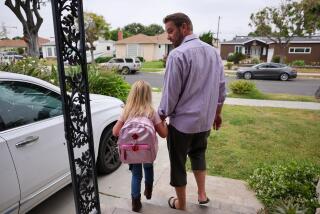There Are Solutions for Problem Students
If you were to poll L.A.’s teachers, you would find that chronically disruptive students are the main reason why teaching is a profession that many feel tempted to leave behind. These unmanageable students are the LAUSD’s hot potato kids, tossed back and forth between teachers and administrators, between one school and another, and who succeed in nothing but preventing their classmates from succeeding. Tragically, however, this problem is an issue seldom if ever frankly acknowledged.
Here’s the life cycle of the disruptive student: By two weeks into the semester, the teacher has learned that the student is behaviorally unmanageable. The individual’s skills may be far below grade level; he or she may be grossly immature; he or she may come to school burdened by personal problems. The teacher then attempts to establish a rapport with the student and provide individualized instruction. However, even if the student shows signs of greater cooperation, the demands of the remainder of the class usually don’t allow the teacher to follow through on this strategy for very long, and any progress is short-lived.
Next, the teacher attempts to contact the child’s parents. If he or she is fortunate enough to make contact and conduct a conference, parental pressure sometimes settles the student down for a week or two, after which the problem behavior usually starts again and the parents bow out of the picture.
Finally, the teacher begins referring the chronically disruptive student to the dean’s office, where he or she is counseled, assigned risible punitive duties such as trash pickup, and, at most, suspended for a few days. After that, the youngster is sent back to the classroom. In no time at all, however, the student is again disrupting everyone and exhausting the teacher, who ultimately must send the child back to the dean’s office for another round in the same pointless cycle.
Once a student has been bandied between the classroom and the dean’s office several times, this hot potato game advances to a new level. Through the “opportunity transfer,” one school’s chronically disruptive student is traded for a kid in the same situation at another school, and the process begins all over again for both kids.
Currently, great hopes are being pinned on proposed “small learning communities” -- large schools broken up into smaller, parallel schools that share the same facilities. But if these structures are merely shrunken versions of what we have now, the chronically disruptive student will continue to hold peers back and demoralize teachers.
What we must create for chronically disruptive kids are special, small, full-day intervention classrooms in the middle of the regular schools. And rather than allowing this intervention academy to be staffed by the newest, most overwhelmed and lowest-paid teachers, we must place in these classrooms our best, most experienced and most successful teachers, in teams. These star teachers, working collaboratively, would provide individualized instruction, experiment with cutting-edge strategies and more attractive curriculum, and receive generous bonuses drawn from the special Title I funds that are now scattered piecemeal throughout failing schools.
These academies would convey the message that in our schools failure is not an option for anyone. When these kids are ready academically and attitudinally, they would return to regular classrooms.
The hardest-to-reach kids would receive the attention our society’s common good demands, and teaching would be one of the most attractive and satisfying vocations once again.
More to Read
Sign up for Essential California
The most important California stories and recommendations in your inbox every morning.
You may occasionally receive promotional content from the Los Angeles Times.










